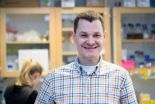(Press-News.org) Following a thorough peer-review process, the researchers who previously announced the detection of B-mode polarization in a patch of the microwave sky have published their findings today in the journal Physical Review Letters (PDF available at http://journals.aps.org/prl/abstract/10.1103/PhysRevLett.112.241101). The researchers provide some evidence that the signals they have found may be the result of gravitational waves from the earliest moments of the universe's existence and thus might constitute the first observation of phenomena from the rapid expansion of the universe known as the inflationary period.
The results from the BICEP2 experiment, the second generation of the Background Imaging of Cosmic Extragalactic Polarization experiment, are controversial in the astrophysics community, with various experts proposing that the signal may be an artifact resulting from distortions created by Galactic dust. The BICEP2 collaboration addresses these claims directly, changing, removing and adding some analyses, but they acknowledge that they cannot rule out the possibility that dust may be partly or entirely responsible for the gravitational-wave-like signals. They anticipate that forthcoming data will resolve this question about their potentially groundbreaking research.
Further information about the significance of the BICEP2 research is available in a special edition of the publication Physics (physics.aps.org), including a Viewpoint article by Lawrence Krauss, a Physics Focus overview by journalist David Lindley discussing a selection of recent Physical Review Letters theory articles on the wide-ranging implications of the finding for cosmology, particle physics and even dark-matter models, and an Editorial by the PRL Editors.
INFORMATION:
ABOUT APS
The American Physical Society is a non-profit membership organization working to advance and diffuse the knowledge of physics through its outstanding research journals, scientific meetings, and education, outreach, advocacy and international activities. APS represents 50,000 members, including physicists in academia, national laboratories and industry in the United States and throughout the world. Society offices are located in College Park, MD (Headquarters), Ridge, NY, and Washington, DC.
BICEP2 researchers publish nuanced account of stunning patterns in the microwave sky
Possibly primordial gravitational waves, but galactic dust not ruled out
2014-06-19
ELSE PRESS RELEASES FROM THIS DATE:
New target: Researchers identify pancreatic cancer resistance mechanism
2014-06-19
Pancreatic cancer tumors addicted to mutant Kras signaling for their growth and progression have a ready-made substitute to tap if they're ever forced to go cold-turkey on the mutant oncogene, scientists at The University of Texas MD Anderson Cancer Center report in the journal Cell.
When researchers dialed up mutant Kras to spur pancreatic cancer growth in mice, and then shut it down, a group of recurrent tumors grew back independently of mutant Kras, reliant on a different oncogene.
"There's a great deal of effort under way trying to find ways to target Kras or some ...
Neurons get their neighbors to take out their trash
2014-06-19
Biologists have long considered cells to function like self-cleaning ovens, chewing up and recycling their own worn out parts as needed. But a new study challenges that basic principle, showing that some nerve cells found in the eye pass off their old energy-producing factories to neighboring support cells to be "eaten." The find, which may bear on the roots of glaucoma, also has implications for Parkinson's, Alzheimer's, amyotrophic lateral sclerosis (ALS) and other diseases that involve a buildup of "garbage" in brain cells.
The study was led by Nicholas Marsh-Armstrong, ...
Emerging HIV epidemics among people who inject drugs in the Middle East and North Africa
2014-06-19
DOHA, QATAR (June 17, 2014) -- HIV epidemics are emerging among people who inject drugs in several countries in the Middle East and North Africa. Though HIV infection levels were historically very low in the Middle East and North Africa, substantial levels of HIV transmission and emerging HIV epidemics have been documented among people who inject drugs in at least one-third of the countries of this region, according to findings published today in PLOS Medicine.
The HIV epidemics among people who inject drugs (PWID) are recent overall, starting largely around 2003 and ...
Possible new combination treatment for cancer
2014-06-19
A few years ago, a molecule known as "JQ1" was developed, which can block so called BET bromodomain proteins. This switch off the known cancer gene MYC thereby preventing cancer cells from dividing.
The discovery was regarded as a major breakthrough. A problem was that JQ1 did not function optimally in animal experiments, and this means that it has not been possible to test the treatment on cancer patients.
New molecule
Jonas Nilsson and his research group have developed, in collaboration with the Canadian company Zenith epigenetics, a new molecule known as "RVX2135", ...
Long-term follow-up after bariatric surgery shows greater rate of diabetes remission
2014-06-19
In a study that included long-term follow-up of obese patients with type 2 diabetes, bariatric surgery was associated with more frequent diabetes remission and fewer complications than patients who received usual care, according to a study in the June 11 issue of JAMA, a diabetes theme issue.
Obesity and diabetes have reached epidemic proportions and constitute major health and economic burdens. Worldwide, 347 million adults are estimated to live with diabetes and half of them are undiagnosed.
Studies show that type 2 diabetes is preventable. The incidence of diabetes ...
New cocaine tracking system could lead to better drug enforcement
2014-06-19
Law enforcement authorities need to better understand trafficking patterns of cocaine in the United States to address one of the world's largest illegal drug markets, according to a Michigan State University researcher whose new methodology might help.
Siddharth Chandra, an economist, studied wholesale powdered cocaine prices in 112 cities to identify city-to-city links for the transit of the drug. He used data published by the National Drug Intelligence Center of the U.S. Department of Justice from 2002 to 2011, which field intelligence officers and local, regional and ...
In hairless man, arthritis drug spurs hair growth -- lots
2014-06-19
A man with almost no hair on his body has grown a full head of it after a novel treatment by doctors at Yale University.
There is currently no cure or long-term treatment for alopecia universalis, the disease that left the 25-year-old patient bare of hair. This is the first reported case of a successful targeted treatment for the rare, highly visible disease.
The patient has also grown eyebrows and eyelashes, as well as facial, armpit, and other hair, which he lacked at the time he sought help.
"The results are exactly what we hoped for," said Brett A. King, M.D., ...
Stem cell mobilization therapy may effectively treat osteoarthritis
2014-06-19
Putnam Valley, NY. (June 19, 2014) – Researchers in Taiwan have found that peripheral blood stem cells can be "mobilized" by injection of a special preparation of granulocyte colony-stimulating factor (G-CSF) into rats that modeled osteoarthritis (OA). The bone marrow was stimulated to produce stem cells, leading to the inhibition of OA progression. The finding, they said, may lead to a more effective therapy for OA, a common joint disease that affects 10 percent of Americans over the age of 60.
The study will be published in a future issue of Cell Transplantation and ...
New digital fabrication technique creates interlocking 3D-printed ceramic PolyBricks
2014-06-19
New Rochelle, NY, June 19, 2014—An innovative system using automated 3D printing technology and advanced digital tools to create customized, prefabricated ceramic building blocks, called PolyBricks, is enabling the construction of mortar-less brick building assemblies at much greater scales than was previously possible. The new techniques that use 3D printers to produce modular ceramic bricks from a single material that then interlock and assemble easily into larger units for architectural applications are described in an article in 3D Printing and Additive Manufacturing ...
Haters spend more time…hating?
2014-06-19
PHILADELPHIA (June 19, 2014) – We already know haters are predisposed to be that way. Now we see they also spend a lot of time at fewer activities than their non-hater counterparts.
But in a twist of irony, that grumpy person at work may actually be pretty good at their job since they spend so much time on fewer activities, thereby giving them the opportunity to hone their skills in specific tasks.
It's all covered in a new study published in the journal Social Psychology. It seems that a person's "dispositional attitude" – whether the person is a "hater" or a "liker" ...
LAST 30 PRESS RELEASES:
Making lighter work of calculating fluid and heat flow
Normalizing blood sugar can halve heart attack risk
Lowering blood sugar cuts heart attack risk in people with prediabetes
Study links genetic variants to risk of blinding eye disease in premature infants
Non-opioid ‘pain sponge’ therapy halts cartilage degeneration and relieves chronic pain
AI can pick up cultural values by mimicking how kids learn
China’s ecological redlines offer fast track to 30 x 30 global conservation goal
Invisible indoor threats: emerging household contaminants and their growing risks to human health
Adding antibody treatment to chemo boosts outcomes for children with rare cancer
Germline pathogenic variants among women without a history of breast cancer
Tanning beds triple melanoma risk, potentially causing broad DNA damage
Unique bond identified as key to viral infection speed
Indoor tanning makes youthful skin much older on a genetic level
Mouse model sheds new light on the causes and potential solutions to human GI problems linked to muscular dystrophy
The Journal of Nuclear Medicine ahead-of-print tip sheet: December 12, 2025
Smarter tools for peering into the microscopic world
Applications open for funding to conduct research in the Kinsey Institute archives
Global measure underestimates the severity of food insecurity
Child survivors of critical illness are missing out on timely follow up care
Risk-based vs annual breast cancer screening / the WISDOM randomized clinical trial
University of Toronto launches Electric Vehicle Innovation Ontario to accelerate advanced EV technologies and build Canada’s innovation advantage
Early relapse predicts poor outcomes in aggressive blood cancer
American College of Lifestyle Medicine applauds two CMS models aligned with lifestyle medicine practice and reimbursement
Clinical trial finds cannabis use not a barrier to quitting nicotine vaping
Supplemental nutrition assistance program policies and food insecurity
Switching immune cells to “night mode” could limit damage after a heart attack, study suggests
URI-based Global RIghts Project report spotlights continued troubling trends in worldwide inhumane treatment
Neutrophils are less aggressive at night, explaining why nighttime heart attacks cause less damage than daytime events
Menopausal hormone therapy may not pose breast cancer risk for women with BRCA mutations
Mobile health tool may improve quality of life for adolescent and young adult breast cancer survivors
[Press-News.org] BICEP2 researchers publish nuanced account of stunning patterns in the microwave skyPossibly primordial gravitational waves, but galactic dust not ruled out




